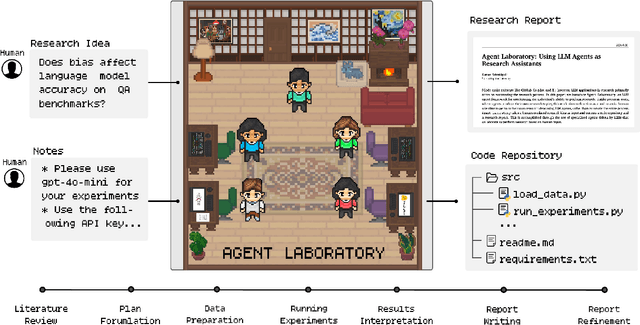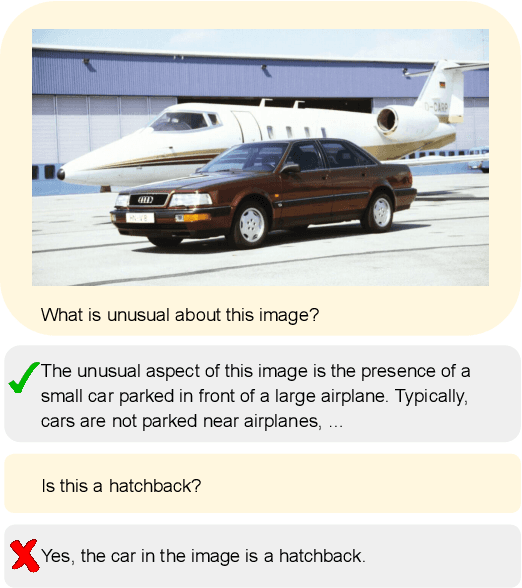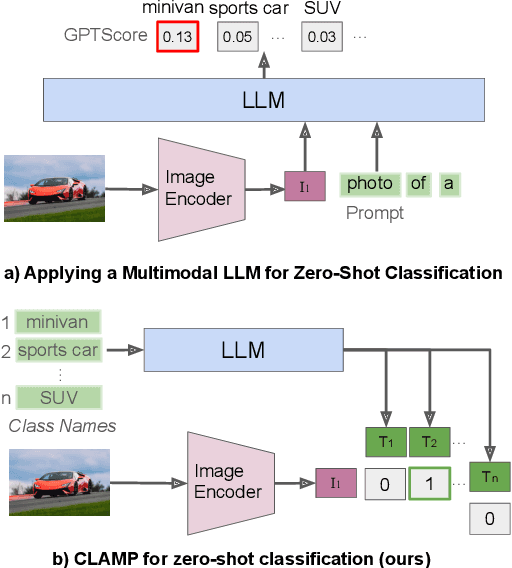Ximeng Sun
Instella-T2I: Pushing the Limits of 1D Discrete Latent Space Image Generation
Jun 26, 2025Abstract:Image tokenization plays a critical role in reducing the computational demands of modeling high-resolution images, significantly improving the efficiency of image and multimodal understanding and generation. Recent advances in 1D latent spaces have reduced the number of tokens required by eliminating the need for a 2D grid structure. In this paper, we further advance compact discrete image representation by introducing 1D binary image latents. By representing each image as a sequence of binary vectors, rather than using traditional one-hot codebook tokens, our approach preserves high-resolution details while maintaining the compactness of 1D latents. To the best of our knowledge, our text-to-image models are the first to achieve competitive performance in both diffusion and auto-regressive generation using just 128 discrete tokens for images up to 1024x1024, demonstrating up to a 32-fold reduction in token numbers compared to standard VQ-VAEs. The proposed 1D binary latent space, coupled with simple model architectures, achieves marked improvements in speed training and inference speed. Our text-to-image models allow for a global batch size of 4096 on a single GPU node with 8 AMD MI300X GPUs, and the training can be completed within 200 GPU days. Our models achieve competitive performance compared to modern image generation models without any in-house private training data or post-training refinements, offering a scalable and efficient alternative to conventional tokenization methods.
Unleashing Hour-Scale Video Training for Long Video-Language Understanding
Jun 05, 2025Abstract:Recent long-form video-language understanding benchmarks have driven progress in video large multimodal models (Video-LMMs). However, the scarcity of well-annotated long videos has left the training of hour-long Video-LLMs underexplored. To close this gap, we present VideoMarathon, a large-scale hour-long video instruction-following dataset. This dataset includes around 9,700 hours of long videos sourced from diverse domains, ranging from 3 to 60 minutes per video. Specifically, it contains 3.3M high-quality QA pairs, spanning six fundamental topics: temporality, spatiality, object, action, scene, and event. Compared to existing video instruction datasets, VideoMarathon significantly extends training video durations up to 1 hour, and supports 22 diverse tasks requiring both short- and long-term video comprehension. Building on VideoMarathon, we propose Hour-LLaVA, a powerful and efficient Video-LMM for hour-scale video-language modeling. It enables hour-long video training and inference at 1-FPS sampling by leveraging a memory augmentation module, which adaptively integrates user question-relevant and spatiotemporal-informative semantics from a cached full video context. In our experiments, Hour-LLaVA achieves the best performance on multiple long video-language benchmarks, demonstrating the high quality of the VideoMarathon dataset and the superiority of the Hour-LLaVA model.
MOVi: Training-free Text-conditioned Multi-Object Video Generation
May 29, 2025Abstract:Recent advances in diffusion-based text-to-video (T2V) models have demonstrated remarkable progress, but these models still face challenges in generating videos with multiple objects. Most models struggle with accurately capturing complex object interactions, often treating some objects as static background elements and limiting their movement. In addition, they often fail to generate multiple distinct objects as specified in the prompt, resulting in incorrect generations or mixed features across objects. In this paper, we present a novel training-free approach for multi-object video generation that leverages the open world knowledge of diffusion models and large language models (LLMs). We use an LLM as the ``director'' of object trajectories, and apply the trajectories through noise re-initialization to achieve precise control of realistic movements. We further refine the generation process by manipulating the attention mechanism to better capture object-specific features and motion patterns, and prevent cross-object feature interference. Extensive experiments validate the effectiveness of our training free approach in significantly enhancing the multi-object generation capabilities of existing video diffusion models, resulting in 42% absolute improvement in motion dynamics and object generation accuracy, while also maintaining high fidelity and motion smoothness.
KeyVID: Keyframe-Aware Video Diffusion for Audio-Synchronized Visual Animation
Apr 13, 2025Abstract:Generating video from various conditions, such as text, image, and audio, enables both spatial and temporal control, leading to high-quality generation results. Videos with dramatic motions often require a higher frame rate to ensure smooth motion. Currently, most audio-to-visual animation models use uniformly sampled frames from video clips. However, these uniformly sampled frames fail to capture significant key moments in dramatic motions at low frame rates and require significantly more memory when increasing the number of frames directly. In this paper, we propose KeyVID, a keyframe-aware audio-to-visual animation framework that significantly improves the generation quality for key moments in audio signals while maintaining computation efficiency. Given an image and an audio input, we first localize keyframe time steps from the audio. Then, we use a keyframe generator to generate the corresponding visual keyframes. Finally, we generate all intermediate frames using the motion interpolator. Through extensive experiments, we demonstrate that KeyVID significantly improves audio-video synchronization and video quality across multiple datasets, particularly for highly dynamic motions. The code is released in https://github.com/XingruiWang/KeyVID.
Self-Taught Agentic Long Context Understanding
Feb 21, 2025Abstract:Answering complex, long-context questions remains a major challenge for large language models (LLMs) as it requires effective question clarifications and context retrieval. We propose Agentic Long-Context Understanding (AgenticLU), a framework designed to enhance an LLM's understanding of such queries by integrating targeted self-clarification with contextual grounding within an agentic workflow. At the core of AgenticLU is Chain-of-Clarifications (CoC), where models refine their understanding through self-generated clarification questions and corresponding contextual groundings. By scaling inference as a tree search where each node represents a CoC step, we achieve 97.8% answer recall on NarrativeQA with a search depth of up to three and a branching factor of eight. To amortize the high cost of this search process to training, we leverage the preference pairs for each step obtained by the CoC workflow and perform two-stage model finetuning: (1) supervised finetuning to learn effective decomposition strategies, and (2) direct preference optimization to enhance reasoning quality. This enables AgenticLU models to generate clarifications and retrieve relevant context effectively and efficiently in a single inference pass. Extensive experiments across seven long-context tasks demonstrate that AgenticLU significantly outperforms state-of-the-art prompting methods and specialized long-context LLMs, achieving robust multi-hop reasoning while sustaining consistent performance as context length grows.
Agent Laboratory: Using LLM Agents as Research Assistants
Jan 08, 2025



Abstract:Historically, scientific discovery has been a lengthy and costly process, demanding substantial time and resources from initial conception to final results. To accelerate scientific discovery, reduce research costs, and improve research quality, we introduce Agent Laboratory, an autonomous LLM-based framework capable of completing the entire research process. This framework accepts a human-provided research idea and progresses through three stages--literature review, experimentation, and report writing to produce comprehensive research outputs, including a code repository and a research report, while enabling users to provide feedback and guidance at each stage. We deploy Agent Laboratory with various state-of-the-art LLMs and invite multiple researchers to assess its quality by participating in a survey, providing human feedback to guide the research process, and then evaluate the final paper. We found that: (1) Agent Laboratory driven by o1-preview generates the best research outcomes; (2) The generated machine learning code is able to achieve state-of-the-art performance compared to existing methods; (3) Human involvement, providing feedback at each stage, significantly improves the overall quality of research; (4) Agent Laboratory significantly reduces research expenses, achieving an 84% decrease compared to previous autonomous research methods. We hope Agent Laboratory enables researchers to allocate more effort toward creative ideation rather than low-level coding and writing, ultimately accelerating scientific discovery.
SoftVQ-VAE: Efficient 1-Dimensional Continuous Tokenizer
Dec 14, 2024



Abstract:Efficient image tokenization with high compression ratios remains a critical challenge for training generative models. We present SoftVQ-VAE, a continuous image tokenizer that leverages soft categorical posteriors to aggregate multiple codewords into each latent token, substantially increasing the representation capacity of the latent space. When applied to Transformer-based architectures, our approach compresses 256x256 and 512x512 images using as few as 32 or 64 1-dimensional tokens. Not only does SoftVQ-VAE show consistent and high-quality reconstruction, more importantly, it also achieves state-of-the-art and significantly faster image generation results across different denoising-based generative models. Remarkably, SoftVQ-VAE improves inference throughput by up to 18x for generating 256x256 images and 55x for 512x512 images while achieving competitive FID scores of 1.78 and 2.21 for SiT-XL. It also improves the training efficiency of the generative models by reducing the number of training iterations by 2.3x while maintaining comparable performance. With its fully-differentiable design and semantic-rich latent space, our experiment demonstrates that SoftVQ-VQE achieves efficient tokenization without compromising generation quality, paving the way for more efficient generative models. Code and model are released.
Koala: Key frame-conditioned long video-LLM
Apr 05, 2024



Abstract:Long video question answering is a challenging task that involves recognizing short-term activities and reasoning about their fine-grained relationships. State-of-the-art video Large Language Models (vLLMs) hold promise as a viable solution due to their demonstrated emergent capabilities on new tasks. However, despite being trained on millions of short seconds-long videos, vLLMs are unable to understand minutes-long videos and accurately answer questions about them. To address this limitation, we propose a lightweight and self-supervised approach, Key frame-conditioned long video-LLM (Koala), that introduces learnable spatiotemporal queries to adapt pretrained vLLMs for generalizing to longer videos. Our approach introduces two new tokenizers that condition on visual tokens computed from sparse video key frames for understanding short and long video moments. We train our proposed approach on HowTo100M and demonstrate its effectiveness on zero-shot long video understanding benchmarks, where it outperforms state-of-the-art large models by 3 - 6% in absolute accuracy across all tasks. Surprisingly, we also empirically show that our approach not only helps a pretrained vLLM to understand long videos but also improves its accuracy on short-term action recognition.
CLAMP: Contrastive LAnguage Model Prompt-tuning
Dec 04, 2023



Abstract:Large language models (LLMs) have emerged as powerful general-purpose interfaces for many machine learning problems. Recent work has adapted LLMs to generative visual tasks like image captioning, visual question answering, and visual chat, using a relatively small amount of instruction-tuning data. In this paper, we explore whether modern LLMs can also be adapted to classifying an image into a set of categories. First, we evaluate multimodal LLMs that are tuned for generative tasks on zero-shot image classification and find that their performance is far below that of specialized models like CLIP. We then propose an approach for light fine-tuning of LLMs using the same contrastive image-caption matching objective as CLIP. Our results show that LLMs can, indeed, achieve good image classification performance when adapted this way. Our approach beats state-of-the-art mLLMs by 13% and slightly outperforms contrastive learning with a custom text model, while also retaining the LLM's generative abilities. LLM initialization appears to particularly help classification in domains under-represented in the visual pre-training data.
Label Budget Allocation in Multi-Task Learning
Aug 24, 2023Abstract:The cost of labeling data often limits the performance of machine learning systems. In multi-task learning, related tasks provide information to each other and improve overall performance, but the label cost can vary among tasks. How should the label budget (i.e. the amount of money spent on labeling) be allocated among different tasks to achieve optimal multi-task performance? We are the first to propose and formally define the label budget allocation problem in multi-task learning and to empirically show that different budget allocation strategies make a big difference to its performance. We propose a Task-Adaptive Budget Allocation algorithm to robustly generate the optimal budget allocation adaptive to different multi-task learning settings. Specifically, we estimate and then maximize the extent of new information obtained from the allocated budget as a proxy for multi-task learning performance. Experiments on PASCAL VOC and Taskonomy demonstrate the efficacy of our approach over other widely used heuristic labeling strategies.
 Add to Chrome
Add to Chrome Add to Firefox
Add to Firefox Add to Edge
Add to Edge